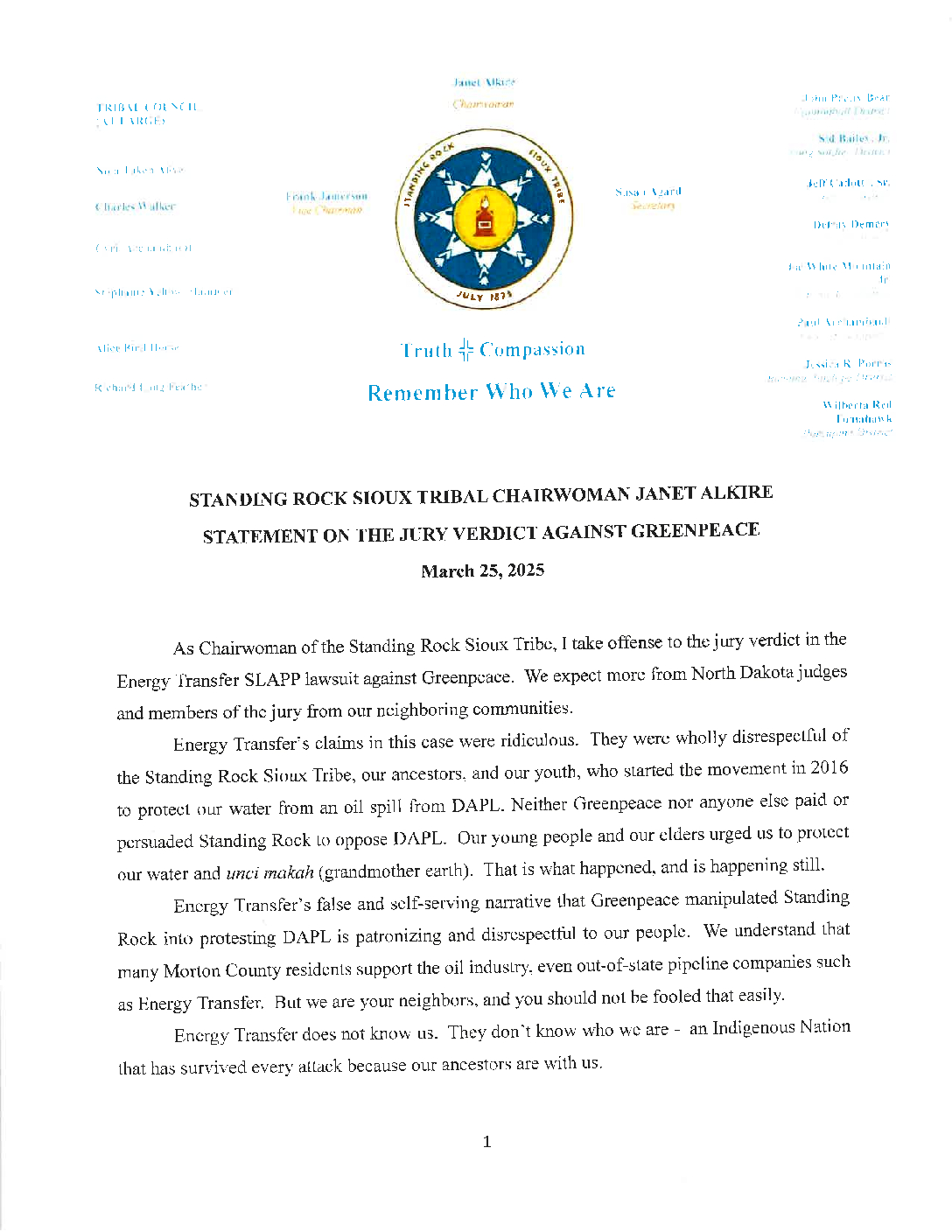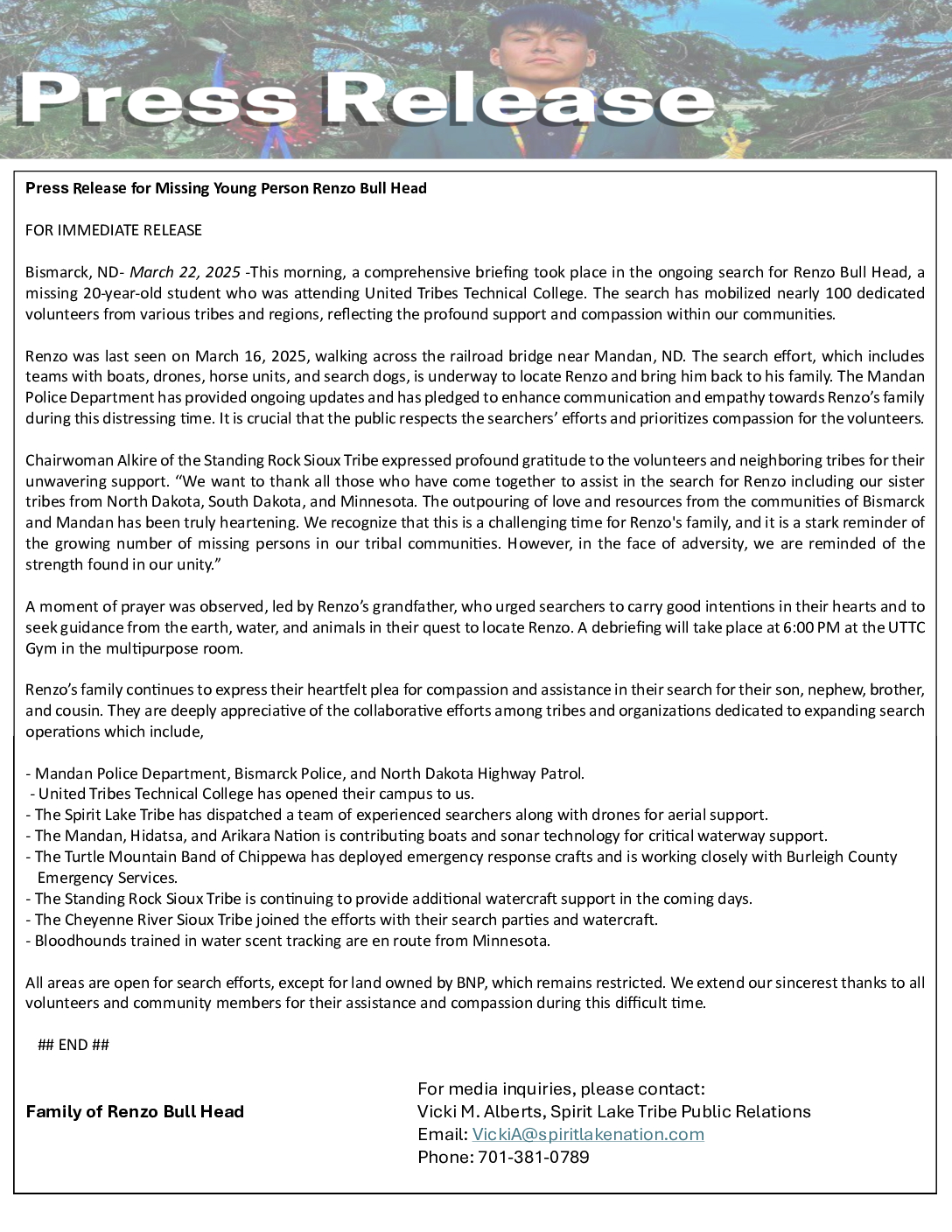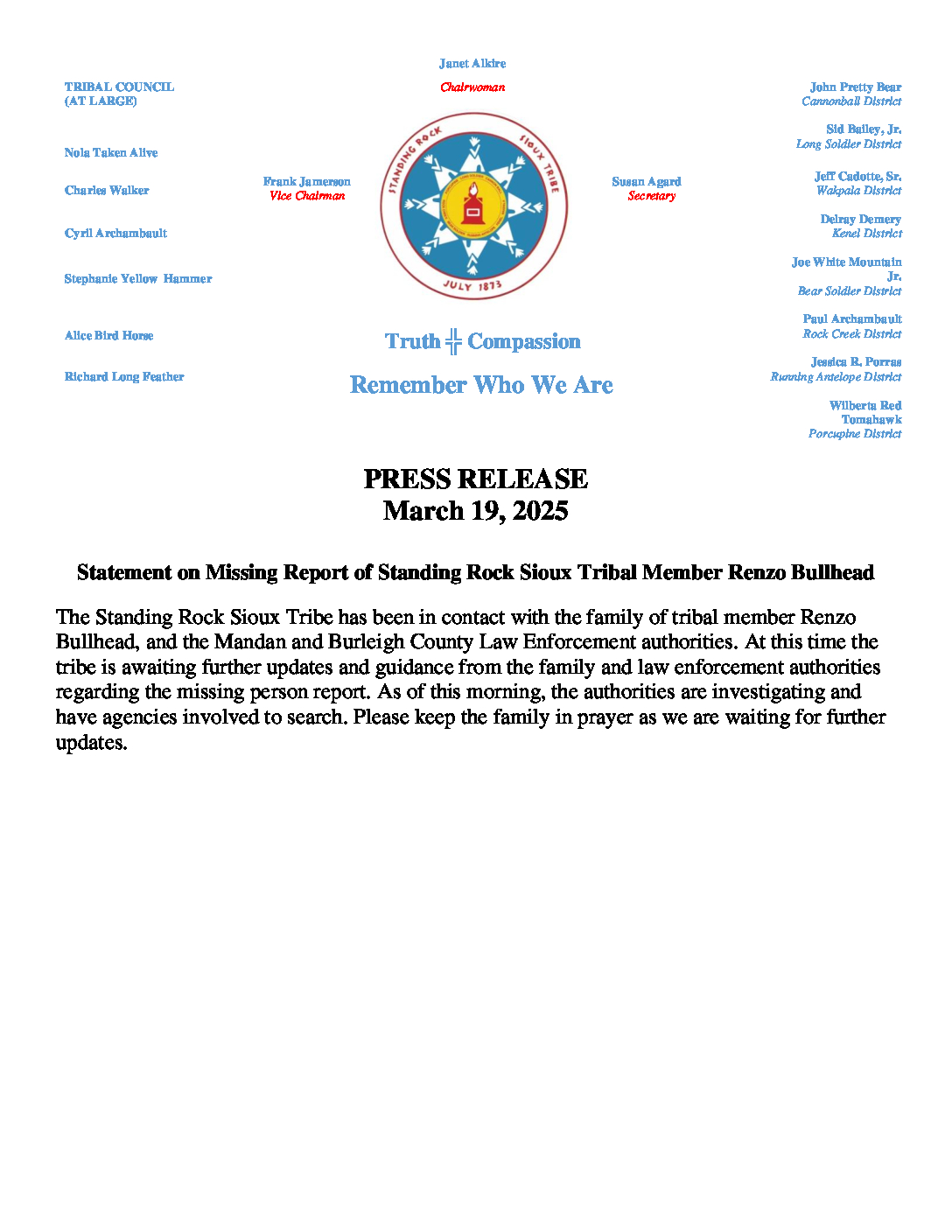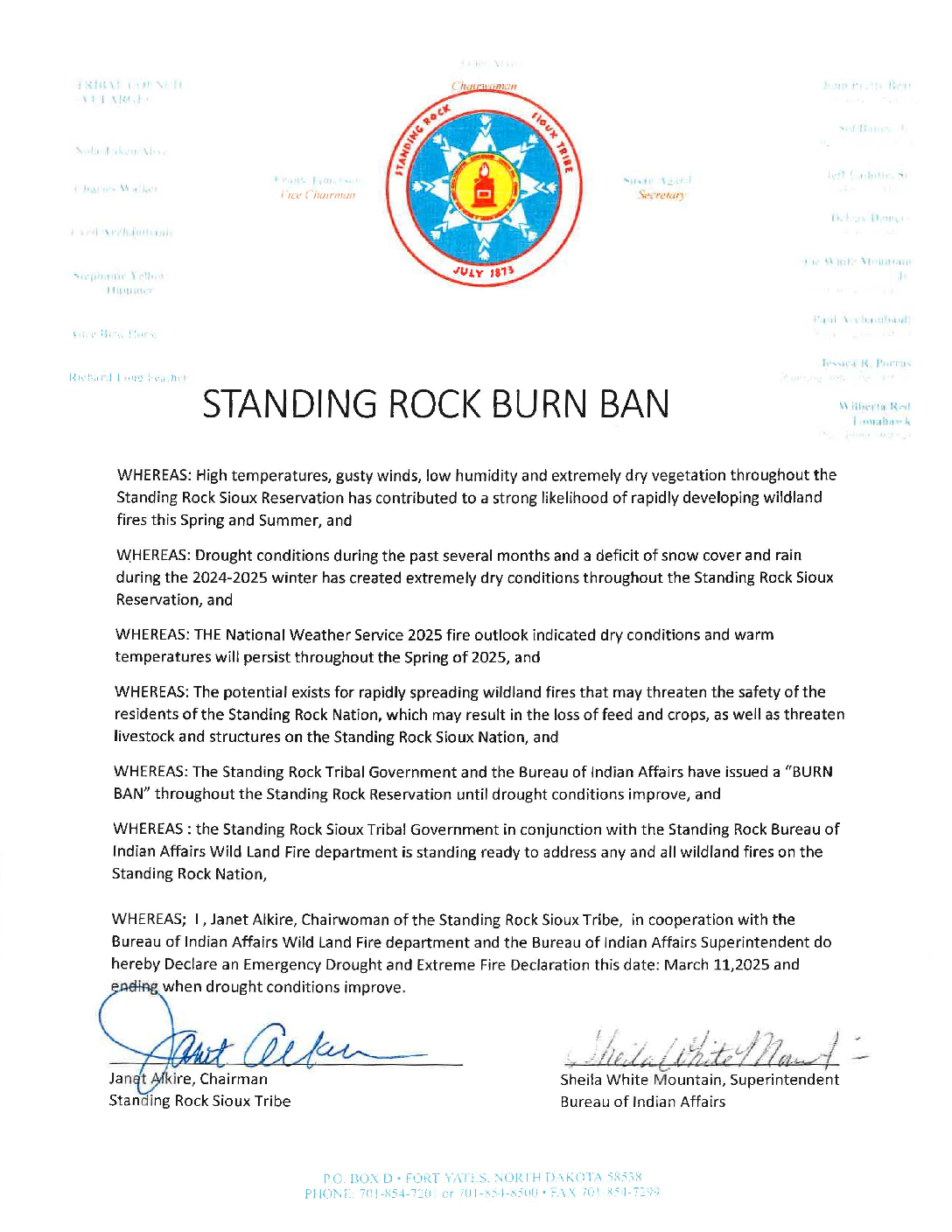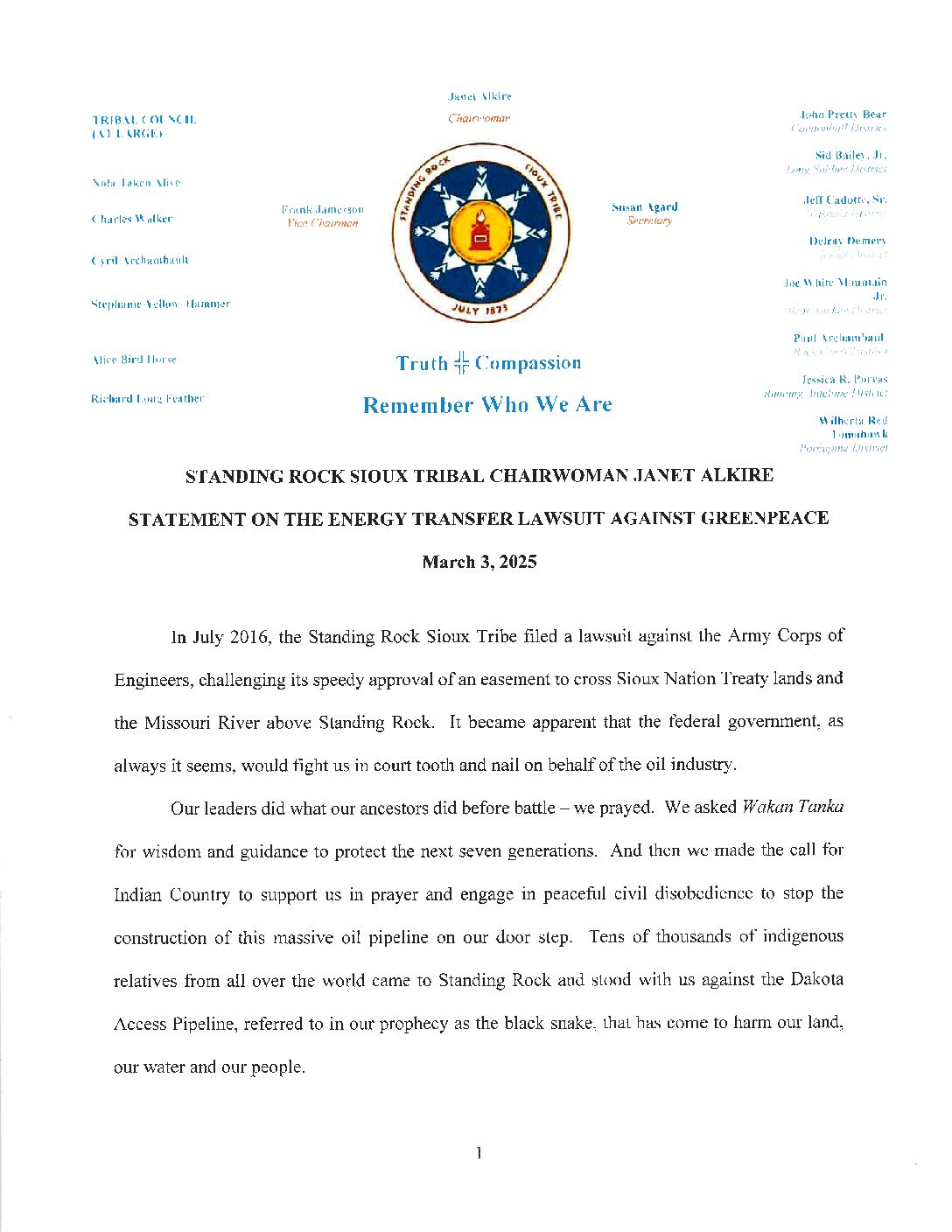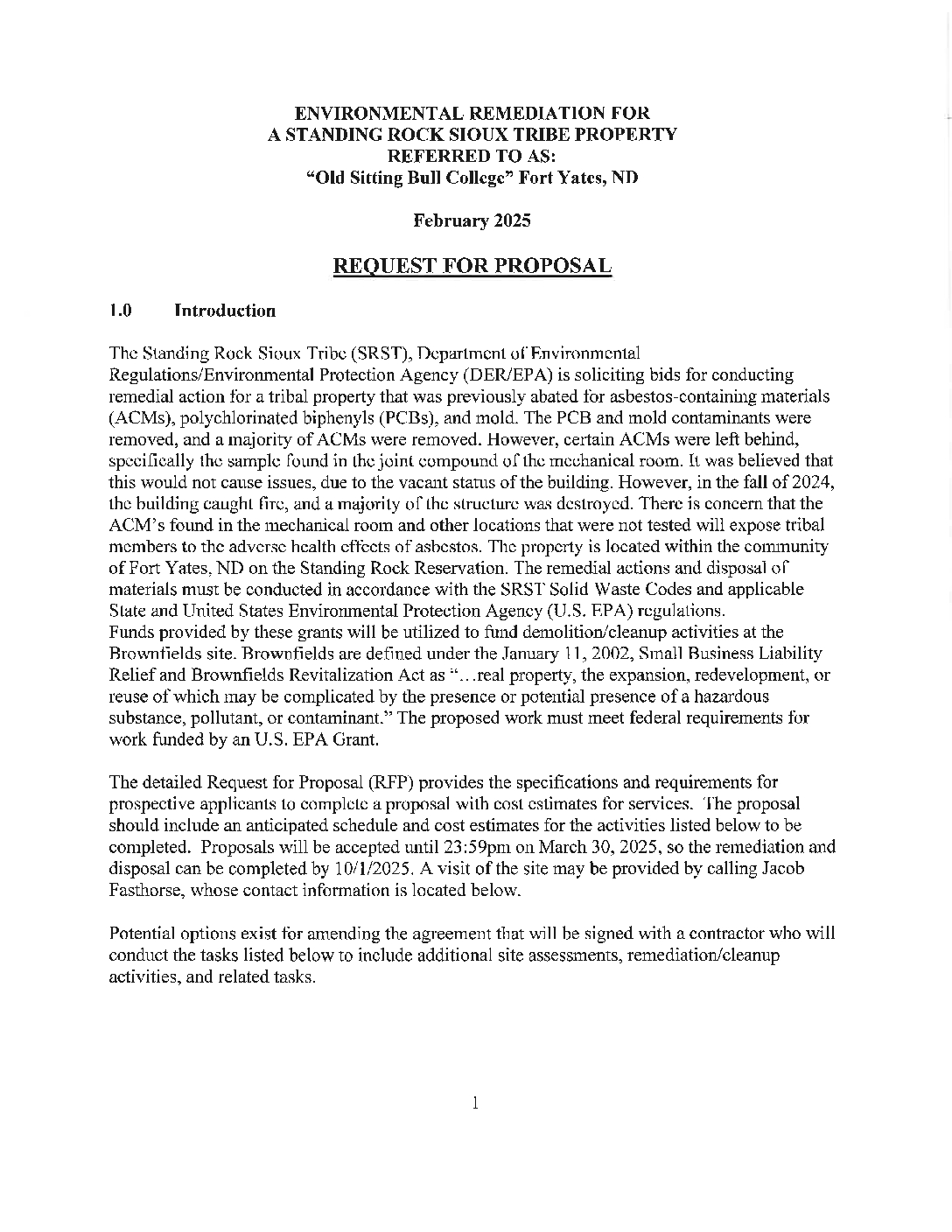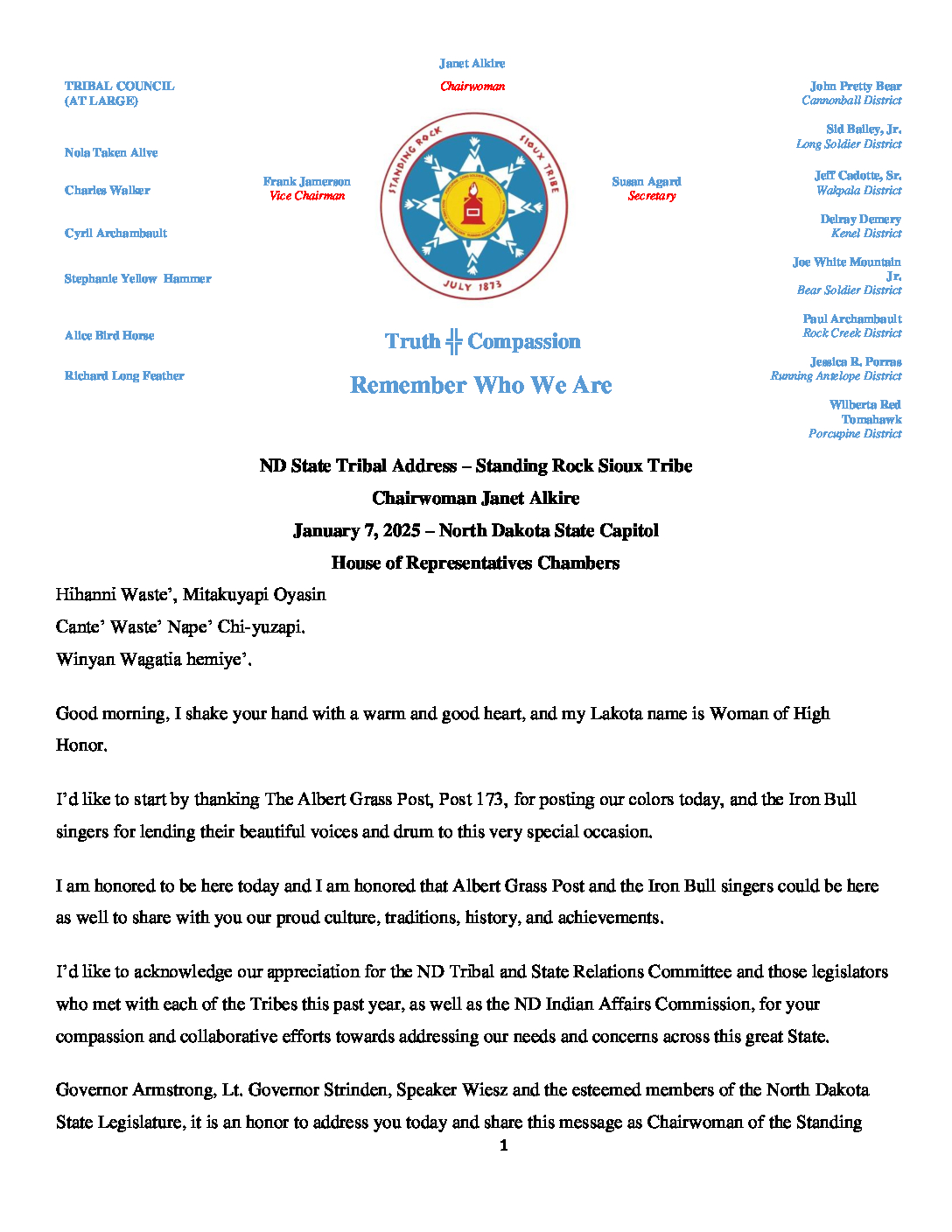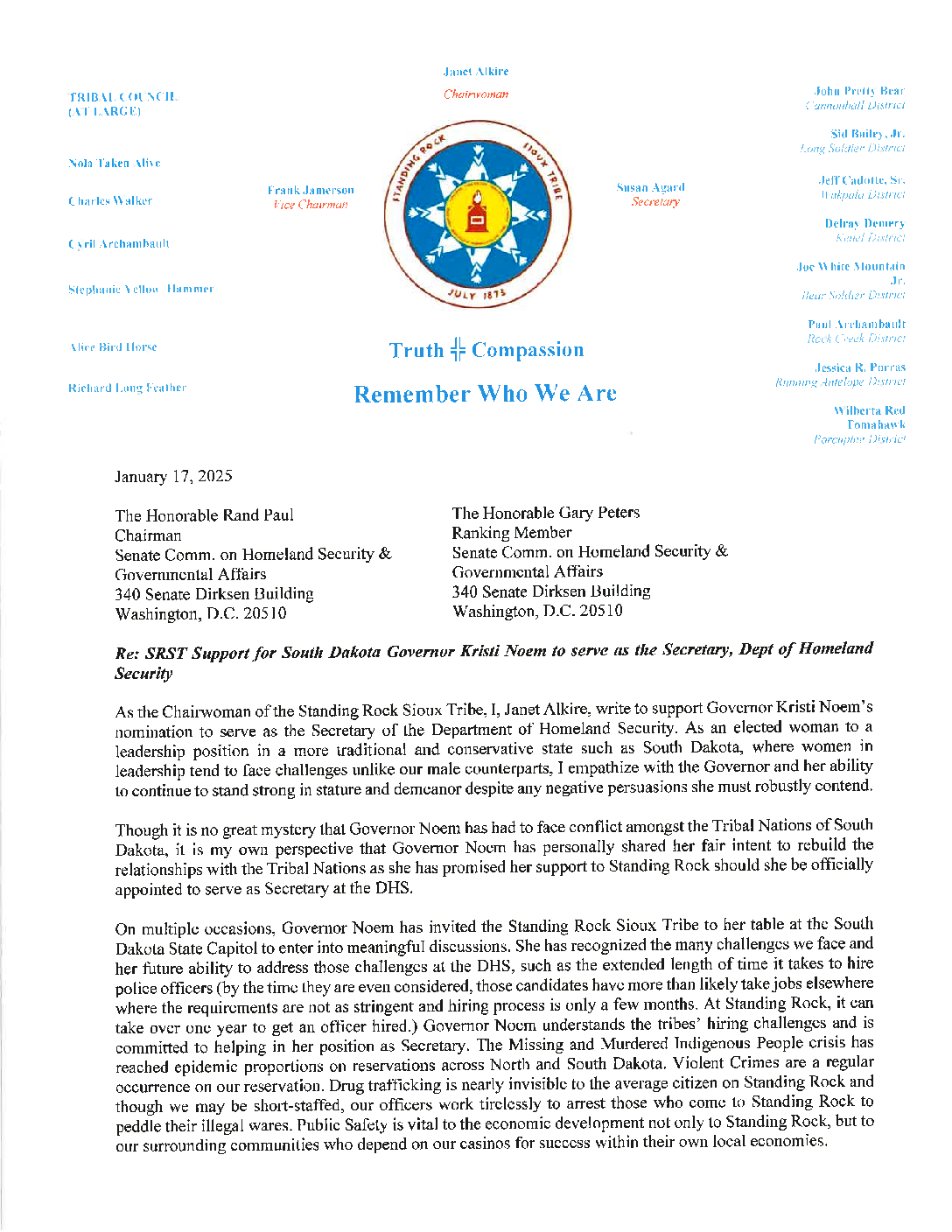Hihanni Waste’, Mitakuyapi Oyasin
Cante’ Waste’ Nape’ Chi-yuzapi.
Winyan Wagatia hemiye’.
Good morning, I shake your hand with a warm and good heart, and my Lakota name is Woman of High Honor. I’d like to start by thanking The Albert Grass Post, Post 173, for posting our colors today, and the Iron Bull singers for lending their beautiful voices and drum to this very special occasion. I am honored to be here today and I am honored that Albert Grass Post and the Iron Bull singers could be here as well to share with you our proud culture, traditions, history, and achievements. I’d like to acknowledge our appreciation for the ND Tribal and State Relations Committee and those legislators who met with each of the Tribes this past year, as well as the ND Indian Affairs Commission, for your compassion and collaborative efforts towards addressing our needs and concerns across this great State. Governor Armstrong, Lt. Governor Strinden, Speaker Wiesz and the esteemed members of the North Dakota State Legislature, it is an honor to address you today and share this message as Chairwoman of the Standing
Rock Sioux Tribe on behalf of our five Tribal Nations: the Mandan, Hidatsa, and Arikara Nation; the Spirit Lake Nation; the Turtle Mountain Band of Chippewa; the Sisseton-Wahpeton Oyate Nation; and Wab Kinew, Premier of the Province of Manitoba who travelled a long distance to be here today. I want to begin this address by sharing some history of my home, The Great Nation of Standing Rock. Among our Lakota and Dakota People, we say the Oceti Sakowin or Seven Council Fires of our Lakota—Nakota—Dakota Oyate or People/Nation. We have a proud tradition as Native Sovereign Nations among our Sioux Nation tribes. At Standing Rock, we have our Hunkpapa and Si ha’Sapa Lakota and our Yankton Dakota People, and we are all relatives united by our common history, traditions, and language as a People. Our 1851 Treaty with America reflects original Great Sioux Nation territory stretching from Minnesota to Montana, Canada to Kansas and
Colorado, and lands in between. Together with our sister Sioux tribes, we are the Dakota in North and South Dakota.
To defend our lives and our homeland, our People fought wars with the Cavalry. The 1868 Great Sioux Nation Treaty reflects the promise that war shall forever cease, and protects our lands as our permanent home. We are proud of our People, Sitting Bull, Rain-in-the-Face, Gall, Two Bears, John Grass, Running Antelope and so many others. Today, our homelands have been reduced to now only 2.3 million acres which straddles the common border with both North Dakota and South Dakota. My people are resilient, innovative, vibrant, educated, and persistent. Standing Rock Sioux Tribe is committed to protecting the language, culture and well-being of its people through economic development, technology advancement, community engagement and education. But what I love most about our people, is our sense of community, our pride in our culture, and our determination to remember our past while building a bridge to the future. Thank you Governor Burgum for signing the dedication of the Cannonball Bridge as the Albert Grass Memorial Bridge. For context, Albert Grass, when he gave the ultimate sacrifice fighting for this country during World War I, was not even a citizen of the United States but served heroically as a strong, indigenous, brave, yet humble Native American. His ancestors live today, and I believe some of them are in this room today, including me. Through the American Rescue Plan and other Federal Funding opportunities, all five Tribal Nations have experienced growth and success by building projects such as housing repairs, medical clinics, various types of rehab facilities, and energy projects.
But this success isn’t just from within the Tribe but through our common work as elected leaders. Our common citizens are our bridge and without the valuable supports they need to cross into a brighter future that infrastructure will collapse. Our kids need quality schools, good jobs, access to impactful health care, secure communities, and leadership that will support them. We, all of us in this room, are critical to their success. A bridge to the future needs infrastructure. America elected change this past November. Change that includes reducing the size of the federal government while also shifting programs more directly to the local level. Though we are not sure how these changes will be implemented or how they will impact the Tribes, the Tribes agree that a reduction in bureaucratic overhead could be extremely beneficial for Tribes like ours. In addition, the move to shift programs within the federal government to areas with stronger implementation infrastructures could result in better use of limited program dollars, BUT WE NEED YOUR HELP TO ENSURE THESE CHANGES HELP OUR COMMON CITIZENS. We must work together with our federal delegation to stress what is best for all our citizens, not just a few. Our tribes need to see improved access to healthcare. Under Medicaid Expansion, Standing Rock and Sisseton are able to exercise self-determination of our health care system access. Standing Rock holds education for its children in high regard. One major and impactful law that the ND State Legislature made was SB-2304. It ensures a greater understanding of Native American history and culture in the classroom and assures that the common student is afforded the opportunity to learn the true history of the plight of the Native Americans in this area. At this time, I would like to commend the State of North Dakota for acknowledging the truth of our past, and our traumas, so that we can move forward not on a path of historical trauma, but on a path of historical healing. Our common children attend both North Dakota schools and Bureau of Indian Education campuses. These students depend on us to ensure they are provided all the tools they need for success. As education bills move through the state and at the federal level, we want to work with you to ensure that the outcomes are in the best interest of all children. I know we agree that the children of our state deserve the best opportunities we can provide them. Some other ways to ensure a better future for our children includes our duty to implement economic development. Economic development on the reservations is critical to the economy of the state as a whole, and strategies must be mutually planned and supported by both Tribal nations and the State of North Dakota. This includes equally sharing of the gaming market to ensure fair opportunities for all. The state must conduct an unbiased and objective study on the economic impacts the five tribal nations have on North Dakota’s gross domestic production and overall economy. This is critical to understanding our joint relationship. We must know our impact on each other to strategize a cooperative future for our common citizens. We are asking for this specifically in the current session.
As leaders, we all understand that the success of building bridges in areas such as Economic Development weigh heavily on a sense of community and public safety. The federal government has been woefully underfunding our law enforcement budgets, creating a crisis that not only impacts our Tribes, but the State we have in common. “Crime doesn’t respect political boundaries”, as Councilman Delray Demery back home has stated many times. I do want to thank the State of North Dakota for supporting a regional Bureau of Indian Affairs (BIA) Advanced Training Center located at North Dakota National Guard – Camp Grafton Training Center. We need the State’s assistance in working with Congress to receive that critical funding because it is a fact that we need additional officers, and to have those officers attend training locally.
I commend the three tribes which have entered into mutual agreements with State entities, such as the ND highway patrol and ND Bureau of Criminal Investigation. These are no doubt an exercise in tribal sovereignty to address public safety in their communities. At this time, I would like to mention and applaud Jayme Davis, District 9 State Representative, who plans to work on a bill which would create a Missing and Murdered Indigenous Peoples’ Alert because of the stress that this issue has on our communities and is in greater need of support. The crisis and the impact of Drug Trafficking along with the MMIP between our shared borders is heart-breaking. For those of you who don’t understand the seriousness of MMIP, it is of epidemic proportions and most Tribes are under-served due to under-funding, so as a result violent crimes and criminal activities are much higher than in non-native areas which have adequate funding and adequate staffing. As I previously stated, crime doesn’t respect political boundaries. Criminal behavior does not end at the reservation border. It spills over across our shared border resulting in criminal behavior in non-native communities as well. This must come to an end. At this time, I’d like to offer a moment of silence for the recent loss of a well-respected Standing Rock BIA Law Enforcement officer, Amber Johnson. The stress of these very demanding first responder positions, can be so mentally, physically, and emotionally challenging, on not only themselves, but also their families and the communities in which they serve.
On behalf of all the Tribal Nations, I want to thank all the first responders for the job they do for ensuring
public safety. That Bridge to the Future I mentioned earlier, it is real. We all agree that we need easier access to services on the east side and west side of the Missouri River. Today, there are only two bridges at Bismarck and Mobridge, South Dakota, that connect the east to the west side of the state, leaving a vast gap of over 120 nautical miles in between. Building a new bridge would not only improve physical connectivity but also symbolize stronger relationships and collaboration between North Dakota and Standing Rock. I was encouraged to hear our legislative council express commitment to finding resources for this project, and I’m proud to share that we have recently secured a $14.5 million grant from the Department of Transportation to help turn this vision into a reality. The bridge serves as more than a physical structure—it represents the bridge to stronger relationships, mutual understanding, and continued collaboration between our tribal nations and the state. As I reflect on my leadership, I think about the impactful conversations and moments shared as a Mother, a Daughter, a Sister, an Auntie, a Tribal Leader, an Air Force Veteran, and citizen of North Dakota.
I want to extend my heartfelt gratitude to former Governor Doug Burgum and all of the wonderful things he did to strengthen good relations between our five Tribal Nations and North Dakota. I have worked to maintain a strong relationship with former Governor Burgum. His ability to stay connected to Tribal leaders through texts, phone calls and in-person visits have strengthened partnerships that positively impact all tribes across North Dakota. I trust that Governor Burgum will serve Indian Country well as a nominee for the position of Secretary of the Department of the Interior because of his knowledge and support of Tribal Sovereignty. We are excited by the election of our Congressman to the North Dakota Governorship. Congratulations to Governor Armstrong and First Lady, Kjersti Armstrong and congratulations to all incoming legislators!! I look forward to our partnership together and continued relationship building with all five Tribal Nations. When we have a common goal, each the State and the Tribes should work together to leverage our networks for the betterment of common citizens, in education, law enforcement, health care, roads, and infrastructure. We are all North Dakotans. Governor Burgum once said that one of the first things he did as Governor was to reach out to Standing Rock to come meet with Tribal Leaders with a commitment to each other, to listen to each other. He also initiated the Government to Government (G2G) summit at the State level to create dialogue
between the State and the Tribes which we found helpful in preserving and nurturing the relationships we have
worked so hard at building. As public servants—whether legislators, council members, chairpersons, or governors—we all understand the personal cost of service to our families, our communities, and the people we represent. Our collective work can create lasting change and brighter futures for the next generation. I extend my heartfelt gratitude to our tribal leadership, our governor, our legislators, and most importantly, our citizens. We may not always see eye to eye, but we must remain united in service to our people of the five nations and the State of North Dakota. Our shared commitment to progress and respect to one another will keep our relationships strong and our communities thriving for generations to come. I want to leave you with this thought. When I became the first woman to be elected to this position in 2021, and the first woman leader in over 70 years, I wanted to be guided by our values. It was clear, the two values I chose that would be my guideposts are: Truth and Compassion.
Truth, because its needed in all leadership positions. Compassion, because we all need to put ourselves in each other’s shoes.
As always, when we meet we call upon Wakan Tanka Tunkasila, our Grandfather the Creator, to guide us and watch over us. We thank the Creator for our lives and for this day and ask blessings upon all of our People. The generations that went before us, our mothers and fathers, grandmothers and grandfathers, we remember today as we respect their spirit of independence, survival, strength of purpose and their sacrifice….their sacrifice for our existence. We remember who we are and we thank you for doing the same, and thank you to all my relatives who made the journey to be here today.
It’s been an honor to give this address today on behalf of all five nations.
Wopila Tanka. Mitakuye Oyasin
